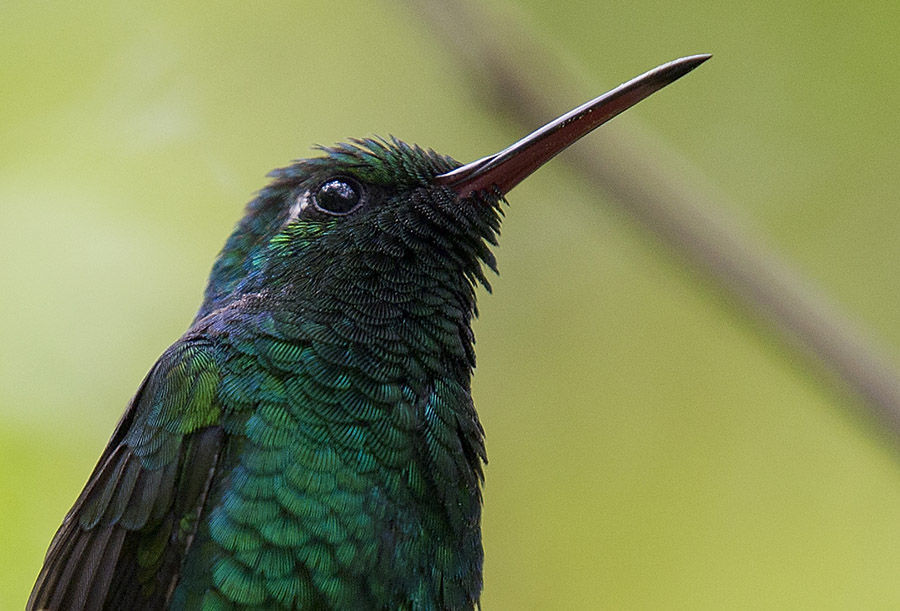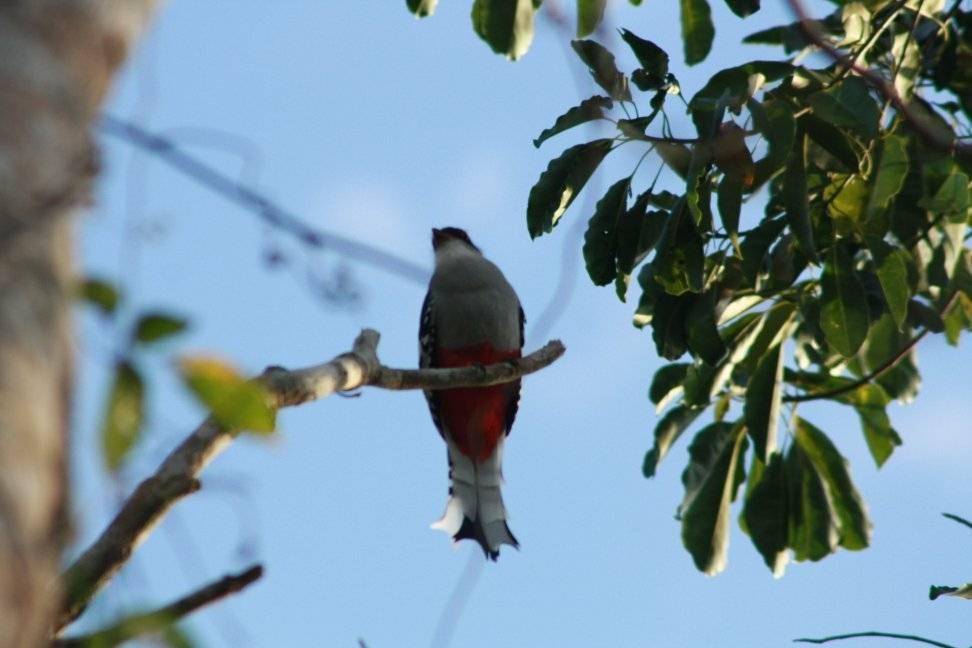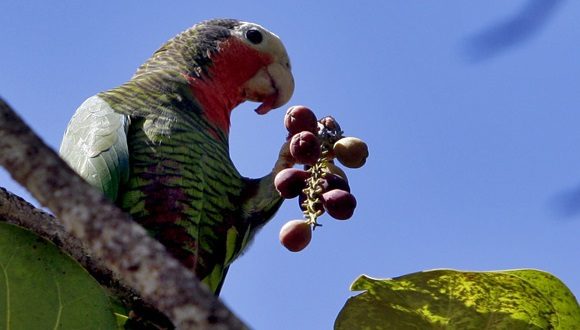
Las Tunas - Among the sound of the electric peeling machine, the "arpeggios" are heard.... The trill mobilizes the looks of the teenagers who form a circle around the barber. The song comes out of eight cages, the "tenants" flutter inside, they go to wallow in small containers of water and then take off again in a tiny flight. The children in the barbershop are engrossed in front of the yellow canary, and little by little the adults also enter into the hubbub of the spectators and the birds.
Yusniel, the barber, has a lot of experience in handling the birds, despite his young age, he manipulates them with dexterity and they seem to assimilate the hand that takes care of them. He assures that he usually pays only for the ones that sing the most, although the chirping sometimes torments him, he says that now he prefers the ones that are born in captivity, even though they are much more expensive.
"Lately I've been buying very little," Yusniel comments with scissors in hand, as he draws strange tips on a customer's head. I only take the ones that catch my attention, the wild ones are very restless and take a long time to sing.
"I have a friend who sells me some birds such as the ones known as painted bunting and Cuban grassquit that he reproduces at home with a lot of work, because the process is complicated, you have to take care of the temperature, the food and many eggs don't hatch. He is addicted to birds. He wants to buy my canary, he offered me three thousand pesos, but I won't get rid of him for any price". This confession sparks a dialogue among the young heads waiting their turn. The tallest of them all says that he is a great hunter. When he goes "fishing" he comes loaded.
This confession sparks a dialogue among the young heads waiting their turn. The tallest of them all says that he is a great hunter. When he goes "fishing" he comes loaded.
"The first time I went to La Veguita I was accompanied by a partner, the trap cage was his and we caught about seven Cuban bullfinches -the 14-year-old boy says proudly-. I sold the three of mine for 50.00 pesos and they flew away. They pay better in town. My mother fought me at first, but then she left me alone, she doesn't want me to keep any of them, because she says they transmit diseases.
"Have you ever seen a fight between Cuban bullfinches? -The question generated expectation among the faces present. They're fierce, they go at it like roosters, and they're so beautiful!
In the hour and a half waiting for a cut, we learned that the ground Cuban grassquit has a yellow ring around its neck and sings beautifully, that the canaries are expensive and not very abundant, and that the Cuban bullfinches have plenty of bravery. We also met society finches and the painted bunting.
Apparently all the clientele gathered there by chance had pet birds at home and knew about cages and traps, and even knew the areas with the best possibilities for a "good harvest". Some were small businessmen and others just consumers; what none seemed to know, not even for a glimpse, that the capture of fantasy birds is punishable by law and not few times they have done it in the nesting season, a real attack to the environment.
UNDER THE PROTECTION OF THE LAW
Although it is not one of the provinces with the highest incidences in the country, the period of isolation was propitious in Las Tunas for the rise of illegalities against flora and fauna. Even when the criminals are not aware of it, this has serious repercussions on the ecosystems and depressed populations of animals and plants.
Juan Elías Arias Gómez, Information and Analysis Technician of the Protection Management Group of the Forest Ranger Corps, assures 26 that with respect to the fight against these behaviors, there has been an increase in the number of fines, above the average of previous years, as well as the amount of money collected for this concept.
We are always alert", he points out. In the territory the main violations are against the flora, specifically the logging and sale of precious, semiprecious and round wood, and we face the capture of any species, especially birds of prey. People want them as pets because of their harmonic songs and elegant plumage.
"Many hunt for trade and take them to areas where their sale brings them the most profit. Certain specimens are used for religious purposes, but we have not seen any cases with these characteristics on Las Tunas soil.
"The main incidences are in the north, where there is the greatest forest and fauna wealth. In the south, Cabaniguán, enjoys good surveillance and strict control, although we do not rule out infractions. San Miguel del Junco, in "Amancio", being a remote area, is prone to hunting. "In the center of the province, birds are concentrated in cages for commercialization inside and outside the locality. We have acted on individuals who have several for this purpose. In Puerto Padre we have also detected illegalities repeatedly. With respect to pigeons, quails and other similar varieties, hunting has been reduced due to lack of cartridges and right now they do not suffer great aggression.
"In the center of the province, birds are concentrated in cages for commercialization inside and outside the locality. We have acted on individuals who have several for this purpose. In Puerto Padre we have also detected illegalities repeatedly. With respect to pigeons, quails and other similar varieties, hunting has been reduced due to lack of cartridges and right now they do not suffer great aggression.
"It is not limited only to winged species, we have faced the possession of some wildlife animals that are even dangerous, such as crocodiles and hutias, which should not be in the hands of the population and their capture is prohibited except for the scientific community.
"With regard to fancy birds, we must point out that when they are nesting and people irresponsibly capture them, the depressed population is damaged, because the eggs that are left unattended generally die."
PRESERVING NATURE'S ALTARS
The Provincial Delegation of the Ministry of Science, Technology and Environment (Citma, by its acronym in Spanish) is well aware of the actions taken against the fauna and forestry heritage. Among its priorities is the prevention of these acts from the second environmental program approved to confront illegalities of this nature with the responsibility of guiding and coordinating together with the agencies that have the power to impose contraventions.
Amado Luis Palma, sub-delegate of Citma, assures that it is a necessity to adopt urgent measures with the objective of counteracting this phenomenon and minimizing its negative environmental, economic, social and cultural effects.
At the planning level, for the period 2021-2030, the environmental strategy typifies the damages caused for many years to the elements of biodiversity," emphasizes the specialist. The trade of these living beings has encouraged irrational behaviors such as the sale of thousands of charismatic species both within and outside the country; a common example is the Cuban parrot.
"The protection and conservation of nature's altars is fundamentally in the hands of the Agro-forestry and Flora and Fauna Conservation companies. In Las Tunas we have a network of nine protected areas, seven of which are under administration, and we are working to ensure that all nine have management and operational plans and projects for the rescue and propagation of species within the 2025-2030 five-year period.
"We have red light bulbs in terms of poaching and depredation on the beaches Los Pinos (Manatí), and La Herradura ('Jesús Menéndez'); there the indiscriminate fishing of chelonians is alarming. These animals are in danger of extinction worldwide and we cannot allow this to continue happening.
"For its part, the case of crocodiles, in this territory, is an example of how much can be done in terms of conservation. In the municipality of Jobabo there is an outstanding reservoir of the American acutus, one of the best sites of its kind in the world."
ALARMS IN FAVOR OF LIFE
The Office of Environmental Regulation and Security (ORSA, by its acronym in Spanish) in the territory, is another of the instances that has within its competencies plans of activities each month to safeguard the natural heritage and confront any action that goes against the good development of this.
The ORSA of Las Tunas, in order to comply with the Governmental Plan for the Confrontation of Crimes and Illegalities against Forest Resources, Flora and Wildlife, participates every month in the meetings of the Provincial Group that governs this activity and is an active member of the Coordinating Board of the Citma Delegation of the province.
Its specialists provide training on Resolution 160 of 2011, which contains the list of species of important significance in our environment. Due to the commercialization of these species, the Governmental Plan arose and to strengthen the contraventional decree, the Animal Welfare Decree Law was recently passed.
With respect to the new animal welfare policy, Renier García Bermúdez, head of the Animal Health Department, assures that finally a guide is established in the country to clarify how to act in the face of illegalities, which are the governing bodies, how the population should proceed and also the contraventions in this regard.
"According to the current legislation, people who intend to have wildlife animals as company need authorization from Citma -says Reinier-, in the case of those qualified of special significance for biological diversity they must have the environmental license that authorizes the acquisition; in case of violations the established contraventions will be applied to them.
"Specifically, it is contained in Chapter 10, Article 51.1, which prohibits the commercialization of live animals, only with prior authorization. In these cases, the species will be confiscated and placed in quarantine and then returned to the wild.
"The environmental policy places Citma as the governing body and confers on it the determination of feral populations and wildlife in works for the protection and recovery, as well as the control or culling of invasive species."
PROTECTION, EDUCATION FOR LIFE
It should be noted that of the 8,447 varieties with different degrees of threat on the planet, registered by the International Union for Conservation of Nature (IUCN), 817 are endemic to Cuba, in addition to the fact that the island has about 7,500 plant species, which makes it occupy the fourth place worldwide and the first in terms of biodiversity, with 53 percent of endemism.
The Cuban grassquit, Cuban bullfinches, society finches and other birds that Yusniel and his entourage capture in cages are in the first column, which, according to Resolution 160 of 2011 of the CITMA, cannot be captured under any circumstances, except for scientific purposes.
Birds, reptiles, mollusks, the list of endangered species is long. There are also many other flora species such as mahogany, cedar and carob trees. Sometimes tourism demands a group of souvenirs that are made at the expense of our natural wealth without being punished with due rigor.
The confrontation must be done by all sectors. In the face of threats, the control mechanisms must be alert because with profits at stake, there will always be those who take the risk of flouting the law, who limit the magic of nature to the few centimeters of a cage, without thinking about the cost of their actions, mistakes that in the long run affect the quality of our lives.